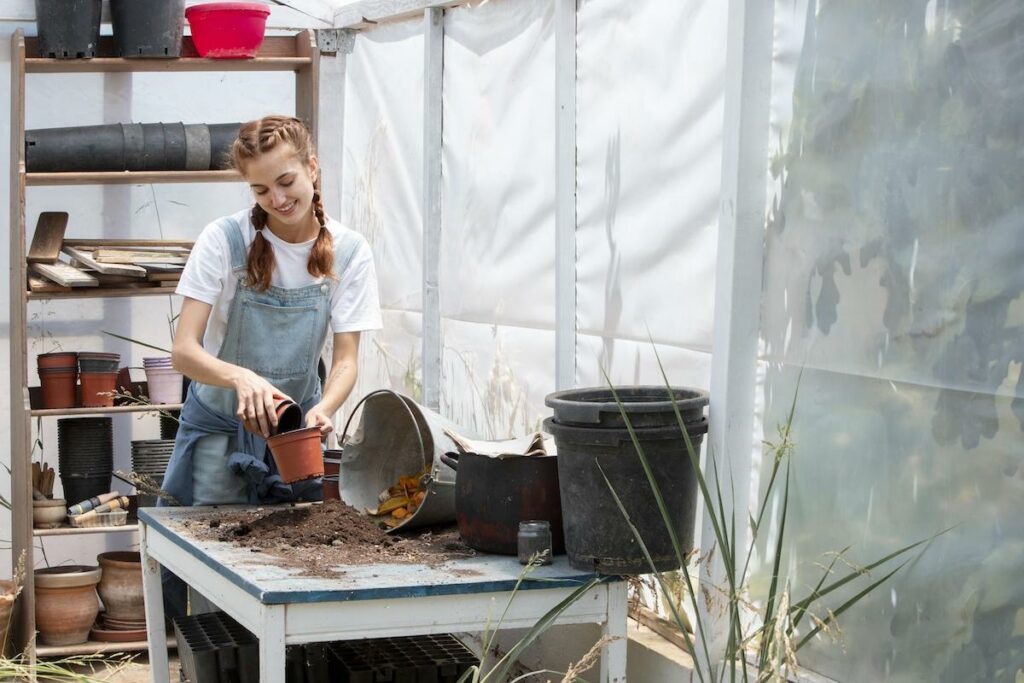Shrinking your carbon footprint as a student may seem pointless — after all, over 70 percent of carbon emissions come from just 100 companies, right? 🤯
But in reality, making sustainable choices is good for the planet, good for your mind, and can even be good for your student budget!
If you want to follow in Greta Thunberg’s footsteps, check out these cheap, accessible, and effective ways you can shrink your carbon footprint.
Are you ready to go green? 🌱
- 1. Say Goodbye to Plastic 🥤
- 2. Swap Fast Fashion for Thrift Stores 🧥
- 3. Go Vegetarian or Flexitarian 🥗
- 4. Learn How to Compost Food Waste 🍌
- 5. Find Eco-Friendly Transportation 🚗
- 6. Reduce Your Electricity Consumption 💡
- 7. Green-ify Your Dorm or Apartment 🏘
- 8. Sign Up (and Show Up) at Community Efforts 🙋🏽♀️
1. Say Goodbye to Plastic 🥤
Okay, you might already know this one, but we’re still including it because it’s so effective: say no to single-use plastic. Whether it’s bags, straws, water bottles, utensils, or packaging, these disposable items significantly damage the environment.
Plastic takes years to decompose, and what’s worse, it finds its way into our oceans (and marine life such as turtles and fish), releasing more toxic chemicals the longer it stays there.

Instead, invest in reusables! ♻️ When you stop by a coffee shop, ask the barista to use your reusable cup, or when you order take out, specifically request that the restaurant doesn’t include plastic cutlery.
Take a tote bag with you when you shop for groceries and avoid products that use too much packaging. You can also replace disposable Tupperware at home with glass ones since they are 100 percent recyclable (plus they are free from harmful chemicals, making them a top choice for healthy food storage).
TIP: Shifting to a plastic-less lifestyle can be difficult. Try making it a month-long challenge with your dormmates or friends to stay on course. Agree on weekly goals (such as only using stainless steel water bottles for seven days straight) and send pictures and updates to one another.
2. Swap Fast Fashion for Thrift Stores 🧥
Ever heard of fast fashion? The term describes an industry that capitalizes on manufacturing affordable garments — inspired by fashion runways and celebrity culture — at record speed to meet shopper demands. 👗
While there’s nothing wrong with keeping up with current trends, you should tread carefully! Our habit of discarding clothes too quickly because they’re out of season leads to overproduction, making fashion one of the most significant contributors to carbon emissions.
If the industry stays on course, we could expect to see a 50 percent increase in greenhouse gas emissions within the next 10 years.
If you need new clothes, thrift stores have plenty of hidden gems that you can add to your wardrobe. This can help you save money, spice up your look with unique pieces, and keep landfills from being piled high with clothing.

You should choose timeless clothing items to buy less. Ignore the people who say that buying second-hand (or repeating outfits) is a crime against fashion — fast fashion is a crime against the environment! 💃🏽
We also recommend you invest in pieces that don’t go out of style, like a simple black dress, a white button-down shirt, good jeans and slacks, and a couple of sweaters. You can always mix and match depending on the occasion.
TIP: Take a good look at what you already have in your wardrobe and figure out how you can change it up. Try flipping some of your pants into shorts (or skirts) or an old dress into a crop top. Still looking for variety? Try a clothes swap with your friends.
3. Go Vegetarian or Flexitarian 🥗
About to take a bite out of a hamburger or pepperoni pizza? Think about this: if every American adopted Meatless Mondays for a year, an individual could save the number of emissions produced by driving 348 miles.
Much like fast fashion, dairy and meat production has been recognized as a top contributor to environmental problems on a global scale.
So, there’s no harm in eating less meat and dairy each week. On top of reducing your carbon footprint, you’re also giving your body a health boost. A holistic diet filled with fruits and veggies is proven to prevent obesity, diabetes, and can even lower your risk of certain types of cancer.

You can still fit healthy protein sources into your meals like tofu and tempeh, as well as beans, nuts, and legumes.
Of course, there’s no pressure to become vegetarian, but cutting back can do more good for your carbon footprint than you may realize. If you want to go the extra mile, try going vegan one day a week!
READ MORE: 23 Cheap and Healthy Recipes Students Can Make in Their Dorm Room
4. Learn How to Compost Food Waste 🍌
It’s time to discover the wonders of composting food scraps! Instead of throwing chicken bones, banana peels, and pizza crusts in the trash, turn those leftovers into soil food.
Composting — or combining food waste, yard trimmings, and wood chips to add to the earth — can improve soil’s properties resulting in better crop yield.
If you’re not completely sold yet, other big benefits of composting include boosting forest and wetlands restoration and reducing the pollution from organic landfills, in turn shrinking your carbon footprint.

The trick to making healthy compost is to use carbon- and nitrogen-rich materials, such as coffee grounds, eggshells, fruit rinds, newspapers, and more.
Choose an appropriate composter that can fit your dorm (try tumblers, steel pails, or composting bins if you don’t have a garden) and layer your leftover scraps, alternating moist and dry materials, on a bed of soil.
Keep your compost moist and cover with anything you can find, turning it every few weeks to introduce air mixture until the mixture is ready. Taking care of this can be a good way to release stress from your classes!
Then, when it’s time, add the compost to potted plants in your room and see your greenery thrive. 🌿
5. Find Eco-Friendly Transportation 🚗
What’s a college student got to do to get around town?
Fossil fuel consumption is a major contributor to greenhouse gas emissions, so you should consider alternative ways to get from point A to point B if you want to reduce your carbon footprint.
Are you studying at one of the most beautiful colleges in the country? If so, take advantage of the scenic route by walking or riding your bike to class.
It’s a guilt-free option that you can also choose to get to nearby bars, diners, and stores (with the bonus of helping you stay healthy in college by getting your step count up).
If this sounds too tiring after a long day of classes, you can always rely on public transportation. Subway trains run on electricity, and while buses run on fuel, they are a more environmentally-friendly choice than cars because they benefit multiple riders.

Need a car? 🚗 Make the most out of it through carpooling. This is an excellent way to reduce your gas spending and help friends or classmates in need.
Since we’ve come a long way with technology, students with more money to spare can also consider investing in a hybrid or all-electric car.
6. Reduce Your Electricity Consumption 💡
Speaking of electricity, did you know that adjusting your power usage habits at home can do wonders for shrinking your carbon footprint?
First thing on the list is to switch off the lights every time you leave a room, even when you’re only going to be away for a minute.

Turning off incandescent bulbs when you’re out for just 60 seconds saves energy. If you have fluorescent ones, it’s 15 minutes.
You should also learn to minimize your plug load. 🔌 Having several appliances running all at once hikes up your energy use, so it’s best to take it easy. Need to print internship application forms or a 10-page paper? Then it’s best not to turn your coffee machine on at the same time!
Tinkering with your room’s temperature too much is another big no-no. Learn to use your windows wisely, especially if the breeze is just right to cool you off during a hot afternoon. When winter comes, invest in thick, cozy blankets and wool socks.
Another tip is to always do full loads of laundry and air dry your clothes. Large appliances like your washing machine and dryer use a lot of power. Need to clean only one pair of socks? Just hand wash them!
7. Green-ify Your Dorm or Apartment 🏘
Hear us out! Whoever told you that the only way to green-ify your living space is to invest thousands of dollars in fancy gadgets — well, they’re lying. 🤭 There are plenty of low or no-cost options suitable for students.
Before you get started, complete an energy audit to assess how much electricity your dorm or apartment uses.

Is your kitchen a red zone for energy consumption? Or do you leave the air conditioner on for too long in your bedroom? Identifying these areas of concern can help you bring your electricity bill (and carbon footprint) down a notch.
You can combine taking shorter showers with installing a low-flow showerhead to save as much as 2,900 gallons of water every year. 🛀🏼 Naturally, make sure your landlord or dorm supervisor gives you the OK first.
It’s also a good idea to shift from incandescent to fluorescent light bulbs because they are 75 percent more efficient. They contain small amounts of mercury gas which can be toxic, but you can avoid this by handling them properly. Plus, fluorescents last far longer than other lightbulbs, so there’s less waste filling up our landfills.
8. Sign Up (and Show Up) at Community Efforts 🙋🏽♀️
Sometimes, the simplest thing you can do to make the world (or your campus) a greener place is to show up and sign up for local environmental campaigns.
Easy ways to advocate for sustainability include supporting community efforts promoting reuse through donation drives or signing petitions against carbon-intensive projects.
If you want to take the next step, you can join climate change activist groups with chapters at your college or in your local area.
The state of California offers compensation for your volunteer hours, so check to see if other states join in on the cause. It could be a win-win situation for you!

You might be thinking: are these student-friendly methods enough to fight a challenge as big and daunting as climate change?
With these small, daily changes, you can help curb your carbon footprint one step at a time. 👣


